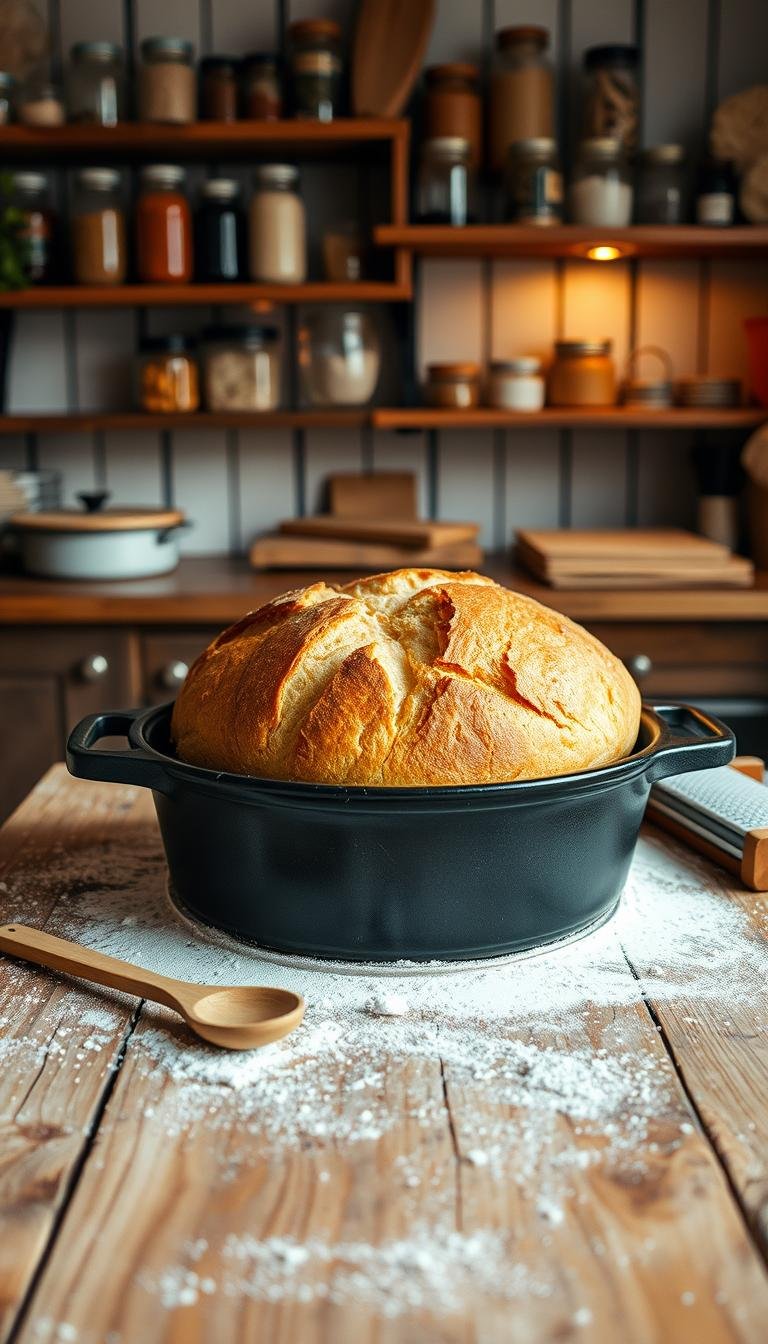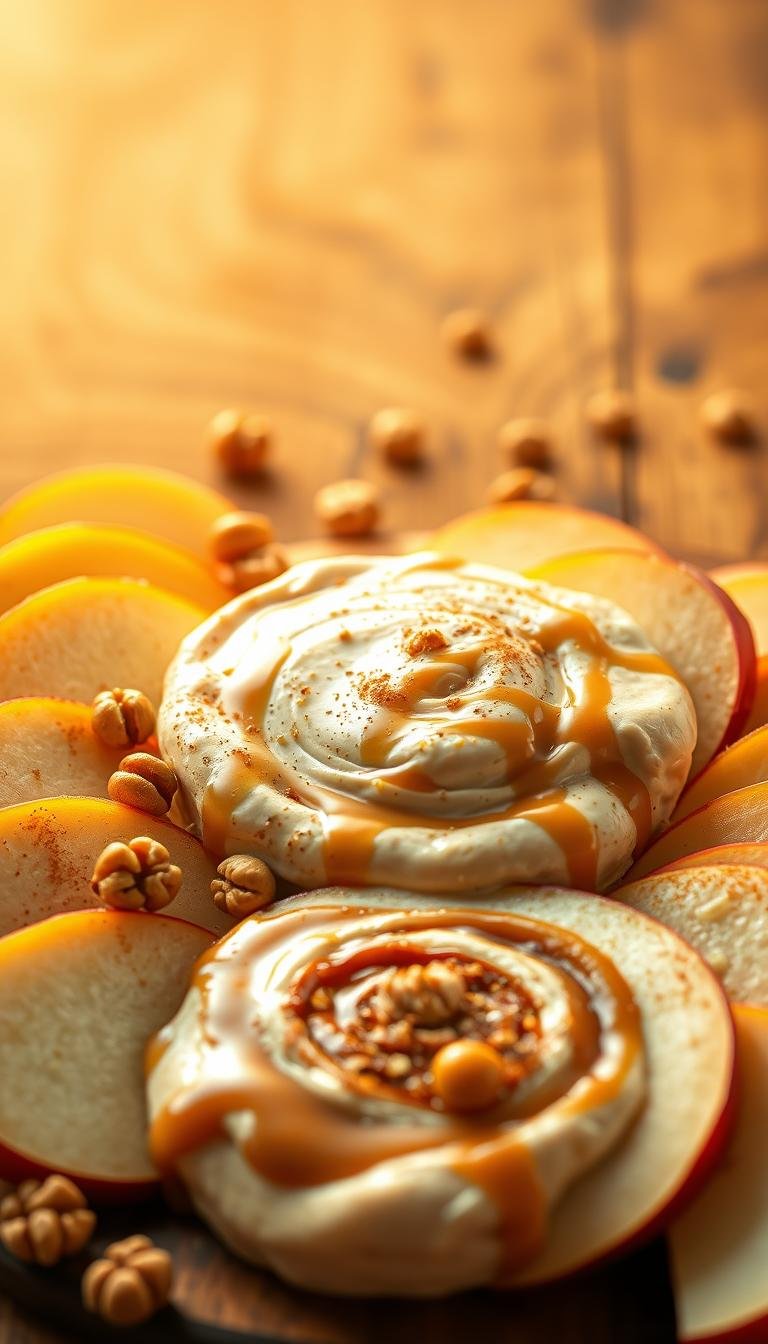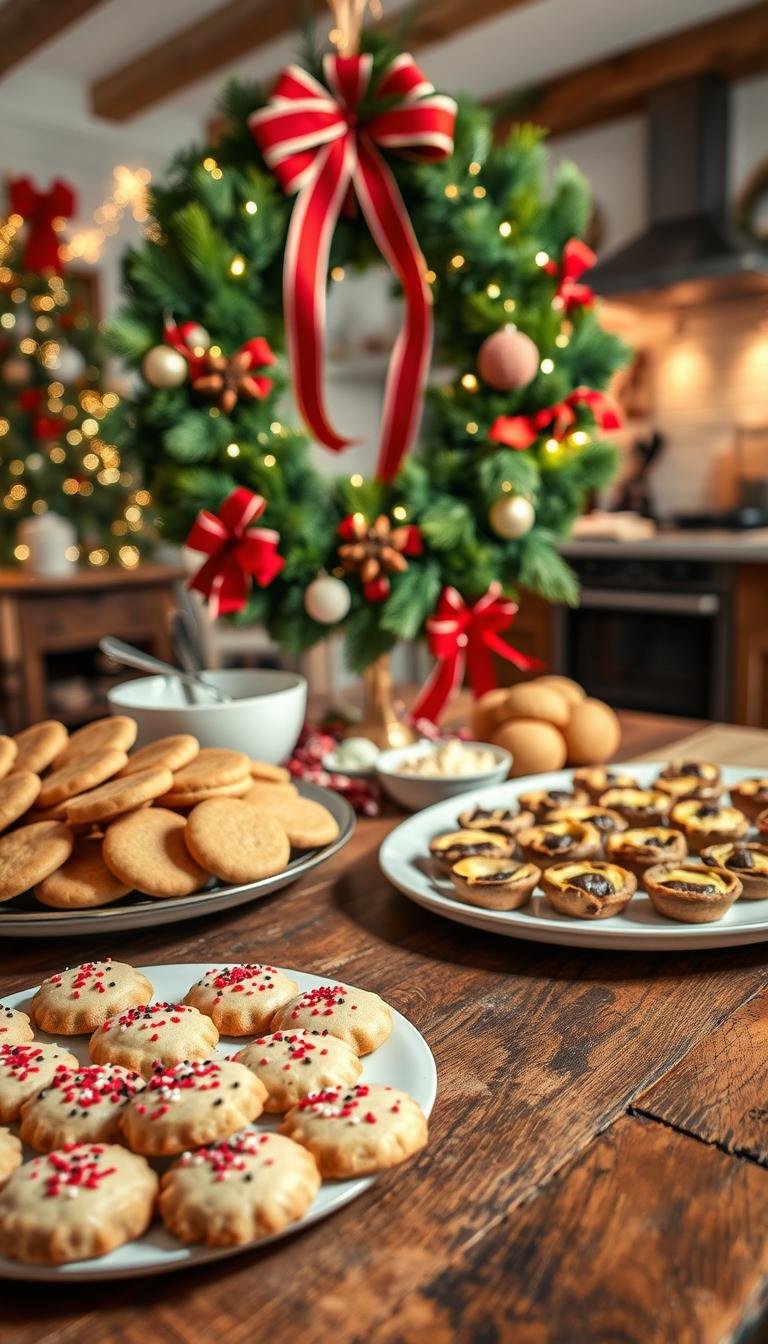25 Best Dutch Oven Bread Recipes for Home Bakers
Artisan bread baking is very popular now. Many home bakers love Dutch oven bread for its easy recipe and great taste. The Dutch oven makes the bread crust crispy and the inside soft.
Whether you’re new or experienced, learning homemade bread recipes can make you better. This guide will show you how to make artisan bread baking and bread making at home easy. You’ll find 25 recipes to make your bread as good as a bakery’s.
Key Takeaways
- Learn the benefits of using a Dutch oven for bread baking.
- Discover 25 carefully selected recipes for homemade bread.
- Understand the science behind creating a crispy crust and soft interior.
- Explore tips and tricks for successful artisan bread baking.
- Start your bread-making journey with confidence.
The Magic of Dutch Oven Bread Baking
The Dutch oven is perfect for baking bread. It traps steam, making the crust crispy and the inside soft. This is key to making great bread.
The Dutch oven’s cast iron keeps heat well. This helps the bread rise and get the right texture. The steam inside makes the crust crispy and tasty.
Baking bread in a Dutch oven is magical. It turns simple dough into a delicious, risen loaf. This makes baking bread at home easy and fun.
Professional bakers use special ovens for this. But, the Dutch oven is easier to use at home. It makes bread that looks and tastes amazing, with a crispy crust.
Essential Equipment and Techniques
Learning to bake Dutch oven bread starts with knowing the right tools and methods. Home bakers need to get familiar with the necessary equipment and ingredients.
Choosing the Right Dutch Oven
There are two main types of Dutch ovens: cast iron and enameled Dutch ovens. Cast iron ones keep heat well and last long. Enameled ones are easier to clean and versatile.
A 5-7 quart Dutch oven is best for bread. It gives the dough enough room to grow. Make sure it has a knob that can handle heat and a lid that fits well.
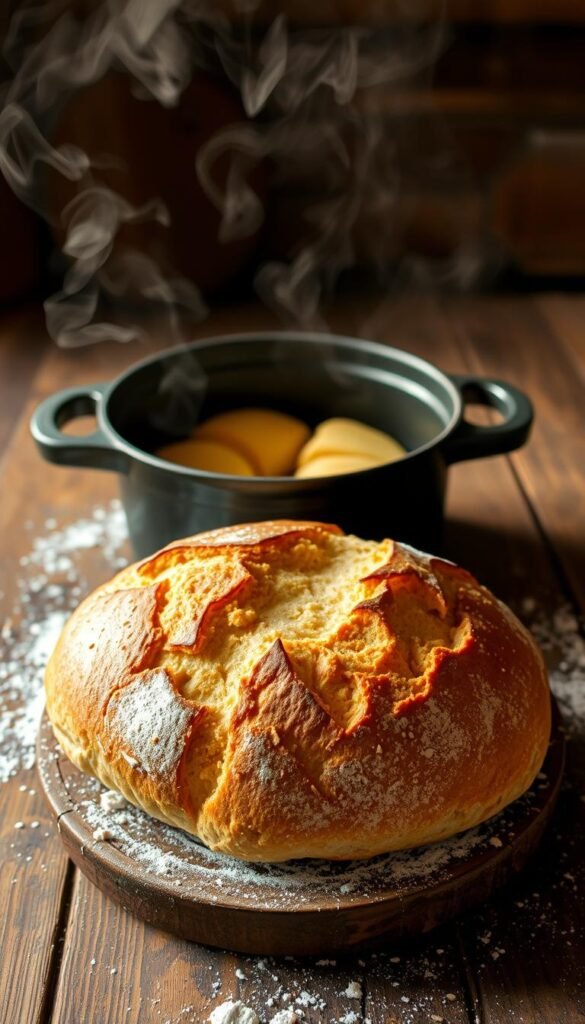
Basic Ingredients for Artisanal Bread
The quality of your bread depends on the ingredients. You can use bread flour, all-purpose flour, whole wheat flour, and rye flour to get different tastes. It’s important to know about yeast, salt, and water quality.
If you want to try something new, making a sourdough starter can add a special touch to your bread.
Helpful Tools for Better Results
Several tools can make your bread-making better. A digital kitchen scale helps with exact measurements. A dough scraper makes handling sticky dough easier.
A proofing basket helps shape your bread. Parchment paper makes moving the dough to the Dutch oven simpler. And a scoring tool lets you make pretty cuts on your bread.
Beginner-Friendly Dutch Oven Bread Recipes
Starting your bread baking journey is easy with Dutch oven recipes. Dutch oven bread is simple and makes great-tasting bread. Beginners should start with recipes that need few ingredients and easy steps.
1. Classic No-Knead Bread
The Classic No-Knead Bread recipe is great for beginners. It mixes flour, water, salt, and yeast, then ferments overnight. This makes a crusty loaf with soft inside.
To make this bread, you need:
- 1 cup of water
- 1.5 teaspoons of salt
- 1 teaspoon of yeast
- 3 cups of flour
Mix the ingredients in a bowl, cover it, and let it sit at room temperature for 12-24 hours. Preheat your Dutch oven to 450°F (230°C) with the lid on. Then, place the dough inside and bake covered for 30 minutes. Bake for an additional 10-15 minutes without the lid.
| Ingredient | Quantity |
|---|---|
| Water | 1 cup |
| Salt | 1.5 teaspoons |
| Yeast | 1 teaspoon |
| Flour | 3 cups |
2. Simple Whole Wheat Bread
Simple Whole Wheat Bread is a healthy choice. It mixes whole grains with white flour for a soft crumb. To make it, mix 2 cups of whole wheat flour, 1 cup of all-purpose flour, 1 teaspoon of salt, 1 teaspoon of yeast, and 1.5 cups of water.
Let the dough rise for a few hours, shape it, and let it rise again. Then, bake in a preheated Dutch oven at 375°F (190°C) for about 40 minutes.
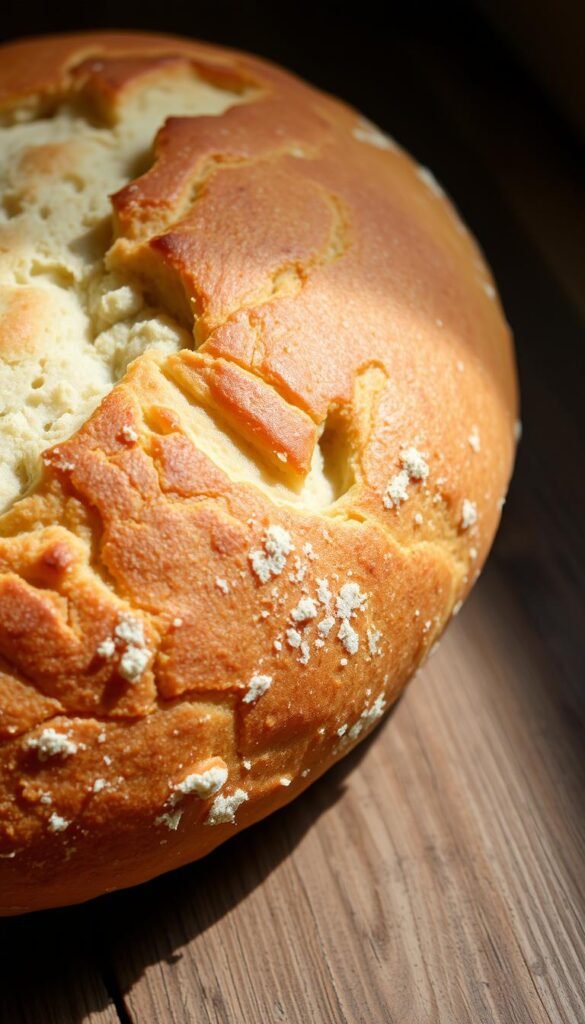
3. Honey Oat Bread
The Honey Oat Bread recipe adds sweetness and texture. It’s perfect for sandwiches and toast. To make it, mix 2 cups of all-purpose flour, 1/2 cup of rolled oats, 1 tablespoon of honey, 1 teaspoon of salt, 1 teaspoon of yeast, and 1 cup of water.
After rising, shape the dough and bake in a Dutch oven at 375°F (190°C) for about 35-40 minutes.
4. Basic Sourdough Boule
Creating a Basic Sourdough Boule is a start to sourdough baking. It needs a sourdough starter for its tangy flavor. Mix your sourdough starter with flour and water to create the dough.
Let it ferment, shape it into a round, and bake in a preheated Dutch oven at 450°F (230°C) for 25-30 minutes.
5. Easy Rustic Italian Bread
The Easy Rustic Italian Bread has a hydrated dough for big holes. To make this bread, mix 3 cups of flour, 1 teaspoon of salt, 1 teaspoon of yeast, and 1.5 cups of water.
After mixing, let the dough rise for several hours, shape it, and bake in a preheated Dutch oven at 425°F (220°C) for about 25-30 minutes.
These recipes help new bakers gain confidence and skills. Each recipe has tips and ideas for trying new things, making bread baking fun.
Savory Herb and Cheese Breads
Explore the flavors of savory herb and cheese breads. They can make any meal better.
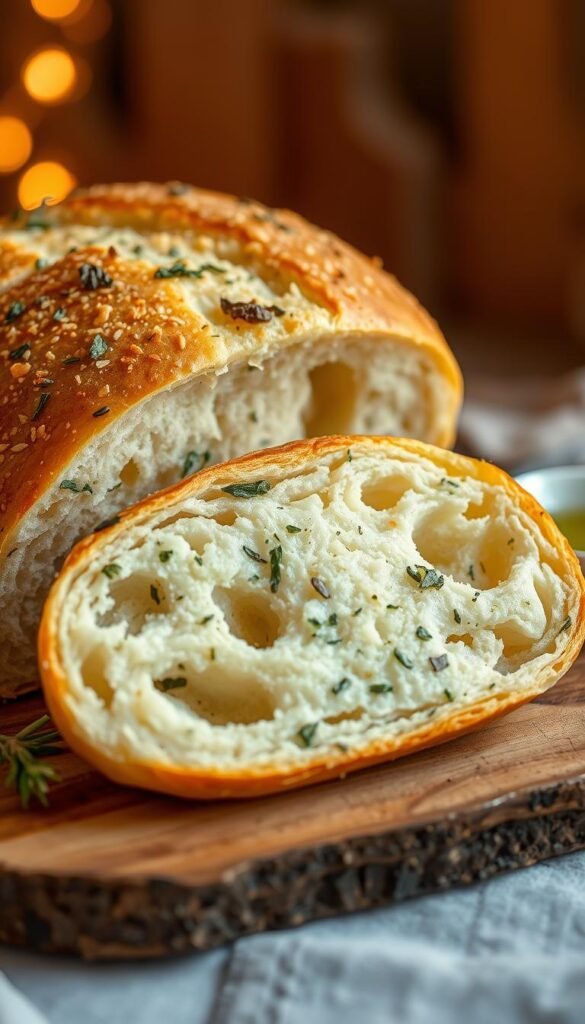
6. Rosemary and Sea Salt Bread
Mix fresh rosemary into your dough. Then, sprinkle flaky sea salt on top before baking. This makes a Mediterranean-inspired loaf.
Tips for preparation: Use fresh rosemary for the best flavor. Choose flaky sea salt for texture.
7. Garlic and Herb Loaf
A garlic and herb loaf is tasty. It has roasted garlic and herbs like thyme and basil. Roasting garlic makes it milder.
Preparing garlic: Roast garlic to soften it. Cut the top off, drizzle with oil, and roast at 400°F for 30 minutes.
8. Cheddar Jalapeño Bread
Cheddar jalapeño bread is spicy. It has sharp cheddar and jalapeños. Mix them into your dough carefully.
Balancing flavors: Adjust jalapeño heat to your liking. Sharp cheddar contrasts the spiciness.
9. Parmesan and Black Pepper Bread
This loaf is great with soups or Italian meals. Parmesan cheese and black pepper add flavor. Grate parmesan and sprinkle black pepper on top.
Using parmesan: Aged parmesan tastes nuttier. Grate it fresh for the best flavor.
10. Caramelized Onion and Thyme Bread
Caramelized onions are sweet. They pair well with thyme. Cook onions until golden, then mix into dough.
Caramelizing onions: Cook onions slowly until golden. This takes about an hour but is worth it.
International Dutch Oven Bread Varieties
Start a journey around the world with Dutch oven bread recipes. They bring flavors from all over to your kitchen. You’ll learn about different breads from Europe and beyond.
Irish Soda Bread with Buttermilk
Irish Soda Bread is a classic from Ireland. It uses buttermilk and baking soda for a soft, dense crumb. The buttermilk and baking soda mix makes the dough rise fast, without yeast.
Traditionally, it’s scored with a deep cross. This is believed to keep evil spirits away.
Crusty French Boule
A Crusty French Boule is a rustic bread from France. It has a crispy crust and open crumb. A Dutch oven helps make it just right.
Tips for a perfect crust: Use steam, score right, and keep dough moist.
| Bread Type | Crust Characteristics | Crumb Structure |
|---|---|---|
| Crusty French Boule | Crispy, golden | Open, airy |
| Irish Soda Bread | Soft, slightly crunchy | Dense, soft |
German Rye Bread
German Rye Bread, or “Roggenbrot,” is dark and dense. It has a unique flavor, often with caraway seeds. Working with rye flour is different because it has less gluten and more fiber.
Rye Flour Tips: Mix rye and wheat flours for better texture. Be patient with longer fermentation.
Mediterranean Olive Bread
Mediterranean Olive Bread is flavorful. It combines the brininess of olives with a soft, crusty loaf. Choosing the right olives and spreading them evenly is key for great flavor.
Olive Selection: Use a mix of green and black olives for a rich taste.
Focaccia with Rosemary and Olive Oil
Focaccia is an Italian flatbread. It’s soft, has dimples, and lots of olive oil. Topped with rosemary and salt, it’s perfect as a side or snack.
Focaccia Tips: Use a wet dough, dimple well, and drizzle with olive oil before baking.
| Recipe | Key Ingredients | Baking Tips |
|---|---|---|
| Irish Soda Bread | Buttermilk, baking soda | Score with a cross |
| Crusty French Boule | Yeast, water | Use steam, score correctly |
| German Rye Bread | Rye flour, caraway seeds | Long fermentation, combined flours |
| Mediterranean Olive Bread | Olives, olive oil | Distribute olives evenly |
| Focaccia | Olive oil, rosemary | High-hydration dough, dimple generously |
Sweet and Enriched Breads
Sweet breads are great for breakfast or dessert. They have sweet parts and soft dough. They’re perfect for any time.
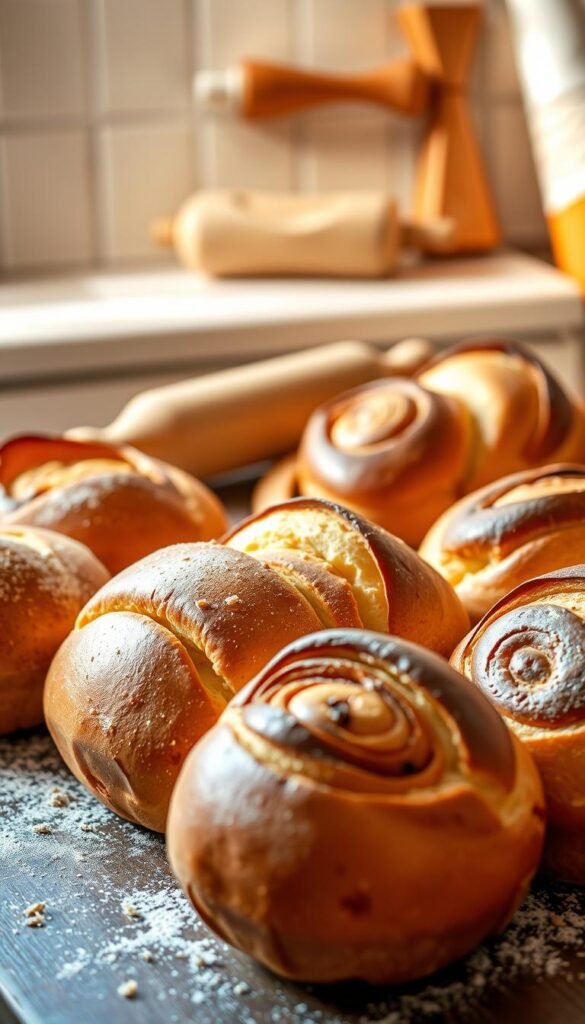
Cinnamon Raisin Swirl Bread
Cinnamon Raisin Swirl Bread is a tasty breakfast choice. It mixes cinnamon’s warmth with raisins’ sweetness. Make sure the dough is smooth for a nice swirl.
Soaking raisins in warm water helps them stay moist. This makes the bread better.
Tips for making Cinnamon Raisin Swirl Bread:
- Use high-quality cinnamon for the best flavor.
- Soak raisins in warm water or rum for added moisture.
- Don’t overmix the dough to maintain a tender crumb.
Orange Cranberry Walnut Bread
This bread is a mix of citrus, fruit, and nuts. Use a microplane grater for the citrus zest. This gets the oils and flavor.
Balance the tartness of cranberries with sugar. Toast the walnuts before adding them. This makes the bread taste better.
“The addition of orange zest and cranberries gives this bread a lovely flavor profile, perfect for the holiday season.” – Baking Expert
Chocolate Babka
Chocolate Babka is a rich, decadent bread. It has chocolate swirls from a lamination process. Working with this dough takes patience and skill.
Getting the braided look is all about rolling and folding. It’s a special touch from Eastern Europe.
Key steps in making Chocolate Babka:
- Prepare a rich, yeast-based dough.
- Laminate the dough with chocolate and butter.
- Roll and fold the dough to create the signature braid.
Brioche Bread
Brioche is a French bread known for its buttery dough. Kneading is key to mix in the butter. Chilling the dough lets flavors grow.
| Brioche Characteristics | Description |
|---|---|
| Rich, buttery dough | High in fat content, making it tender and flavorful. |
| Extended proofing time | Allows for full development of flavors and texture. |
| Golden crust | A result of egg wash and proper baking techniques. |
Apple Cinnamon Bread
This bread is great for fall. It mixes apples’ sweetness with cinnamon’s warmth. Use the right apples and cook them a bit before adding.
The aroma of apple cinnamon bread baking is irresistible, filling the home with warmth and comfort.
25 Best Dutch Oven Bread Recipes for Advanced Home Bakers
Advanced home bakers love making Dutch oven bread. They need to be precise, patient, and creative. This section has five recipes for them to try. These recipes are for those who want to make truly special bread.
Artisan Multigrain Bread with Seeds
Artisan multigrain bread needs different grains and seeds. You can use spelt, barley, and oats. Add flax, sunflower, and pumpkin seeds too.
To soak these ingredients, make a soaker. This makes the bread healthier and tastier. It’s important to get the right mix of water and time for the dough.
Tips for success: Mix different grains and seeds for a rich taste. Make a soaker to soak the ingredients well.
Sourdough Rye with Caraway
Sourdough rye bread is special because of its high rye flour. This makes the dough sticky. But, longer fermentation times make it taste better.
The caraway seeds add a unique taste and texture. It’s all about finding the right balance.
Key considerations: Use autolyse to handle stickiness. Mix the caraway seeds with the sourdough’s tanginess.
Crusty Ciabatta Bread
Making ciabatta bread is a challenge. You need a very wet dough, up to 80% water. Stretch-and-fold techniques are key to get the bread’s holes and crust right.
Technique tip: Stretch-and-fold helps build gluten without over-working the dough.
Fig and Walnut Sourdough
Adding figs and walnuts to sourdough is tricky. You must time them right to avoid burning. Keeping the dough cool is important.
Balancing act: Add figs and walnuts carefully. Mix sweet and tangy flavors well.
Sprouted Ancient Grain Bread
Using sprouted grains like einkorn and spelt makes the bread healthier. First, soak the grains until they sprout. Then, dry and grind them into flour.
Nutritional boost: Sprouting grains makes them more nutritious. It also adds depth to the bread’s taste.
Troubleshooting and Pro Tips
To make perfect Dutch oven bread, knowing common problems is key. Dutch oven bread baking is rewarding but can have challenges. These can affect the bread’s quality.
Common Dutch Oven Bread Problems
Bakers face issues like dense or gummy bread. This often comes from underproofing or underbaking. Make sure your dough proofs well and bakes until it’s just right.
Another problem is burnt bottoms. Use parchment paper or a thin layer of cornmeal to help. If the crust is pale, try increasing the oven temperature or baking with the lid off longer.
Storage and Serving Suggestions
Storing bread right keeps it fresh. Cool the bread, then store it in a paper bag or a breathable container. This keeps it crusty.
For longer storage, freeze the bread. Wrap it tightly in plastic wrap or foil and put it in a freezer-safe bag. To serve, refresh day-old bread in a low oven.
You can also use stale bread. Make homemade croutons, bread pudding, or panzanella salad for a fun twist.
Conclusion
Starting a bread baking journey with a Dutch oven is exciting. It brings many benefits, like easy steps and amazing tastes. You’ve seen 25 recipes that show you can do more than just start.
The homemade bread world is full of help. You can find classes and online groups to learn and share. With these resources, you’ll make bread at home that will wow everyone.
Baking is more than just making food. It’s about the fun of kneading, waiting for the bread to bake, and sharing it with others. Dutch oven bread is a great way to begin. It lets you make bread that tastes like it came from a bakery, with just a few tools.
